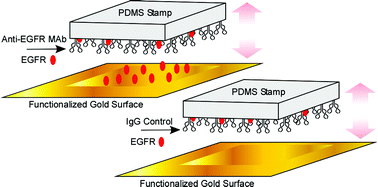Elastomers based on poly(dimethylsiloxane) (PDMS) are promising materials for fabrication of a wide range of microanalytical systems due to their mechanical and optical properties and ease of processing. To date, however, quantitative studies that demonstrate reliable and reproducible methods for attachment of binding groups that capture complex receptor proteins of relevance to biomedical applications of PDMS microsystems have not been reported. Herein we describe methods that lead to the reproducible capture of a transmembrane protein, the human epidermal growth factor (EGF) receptor, onto PDMS surfaces presenting covalently immobilized antibodies for EGF receptor, and subsequent isolation of the captured receptor by mechanical transfer of the receptor onto a chemically functionalized surface of a gold film for detection. This result is particularly significant because the physical properties of transmembrane proteins make this class of proteins a difficult one to analyze. We benchmark the performance of antibodies to the human EGF receptor covalently immobilized on PDMS against the performance of the same antibodies physisorbed to conventional surfaces utilized in ELISA assays through the use of EGF receptor that was 32P-radiolabeled in its autophosphorylation domain. These results reveal that two pan-reactive antibodies for the EGF receptor (clones H11 and 111.6) and one phosphospecific EGF receptor antibody (clone pY1068) capture the receptor on both PDMS and ELISA plates. When using H11 antibody to capture EGF receptor and subsequent treatment with a stripping buffer (NaOH and sodium dodecylsulfate) to isolate the receptor, the signal-to-background obtained using the PDMS surface was 82 : 1, exceeding the signal-to-background measured on the ELISA plate (<48 : 1). We also characterized the isolation of captured EGF receptor by mechanical contact of the PDMS surface with a chemically functionalized gold film. The efficiency of mechanical transfer of the transmembrane protein from the PDMS surface was found to be 75–81%. However, the transfer of non-specifically bound protein was substantially less than 75%, thus leading to the important finding that mechanical transfer of the EGF receptor leads to an approximately four-fold increase in signal-to-background from 20 : 1 to 88 : 1. The signal-to-background obtained following mechanical transfer is also better than that obtained using ELISA plates and stripping buffer (<48 : 1). The EGF receptor is a clinically important protein and the target of numerous anticancer agents and thus these results, when combined, provide guidance for the design of PDMS-based microanalytical systems for the capture and isolation of complex and clinically important transmembrane proteins.

You have access to this article
 Please wait while we load your content...
Something went wrong. Try again?
Please wait while we load your content...
Something went wrong. Try again?


 Please wait while we load your content...
Please wait while we load your content...